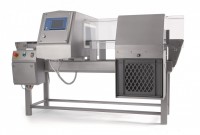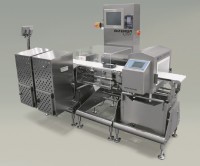Bizerba SE & Co. KG
How can Bizerba prevent recall campaigns?
There are several reasons why manufacturers will decide to invest into an inspection system. They may want to detect faulty products in order to ensure maximum product quality, comply with applicable laws, avoid further recall campaigns, automate the secondary packaging process, fulfill the requirements of their internal foreign-object management process and ensure that flawless products will not be declared as insufficient at a later date.
Based on many years of experience in the inspection sector, Bizerba is capable of detecting many different materials. There are numerous possibilities that can be adapted to the specific requirements of the ready-meal industry.
Today, most companies routinely use metal detectors at the end of their process chain right after the packaging machinery. Bizerba’s Varicon+ metal detection system generates an electric field within the range of its coil. Any product passing through the detector generates a specific pattern, and any deviation from this pattern is an indication of contaminants and will trigger an ejection process. In order to achieve adequate functionality, the system must be trained for each product.
This technology reaches its limits when the products to be inspected have a high ‘product effect’. This includes products packed in tin foil. Due to its high conductivity, this material reduces the metal detector’s precision. Consequently, reliable detection of small contaminants cannot be ensured. In the case of food products packed in containers like E2 boxes, metal objects must have a diameter of 7 mm or more to make the system issue an alert.
Checkweighers with metal detectors: flawless and balanced
According to the pre-packaging regulation, food producers must check the correctness and completeness of the content of any packed and equalized product that reaches the market. The production process is required to continuously document that the filling quantity is not be less or greater than the nominal value. Automatic checkweighers ensure compliance with the pre-packaging regulation. They can be used to check the filling quantity and for process control processes. A feedback function prevents excessive product quantities in the package which would result in unintentional product giveaways. This saves valuable raw materials and increases the manufacturer’s earnings. Thanks to the metal-detection functionality of the combined checkweigher, costly recall campaigns will be avoided. Brand loyalty and customer satisfaction will improve as well.
X-ray technology: no chance for glass, plastics etc.
Featuring excellent detection accuracy, X-ray technology can detect even minor metal particles or stones. Inspection systems like the Bizerba XRE_2 generate a grey image from the captured radiation. Any foreign objects in the food will appear as dark spots in the digital image due to their higher density. Modern X-ray detectors like the Bizerba XRE_2 can process the image within milliseconds, enabling the conveyor to run through the system at a speed of 60 meters per second. This corresponds to approximately 200 packages per minute. As an additional advantage, a distance of only 10 millimeters is required between packages contrary to similar devices, enabling an extremely high throughput.
The system is also adaptable to individual requirements. For instance, manufacturers can selectively exclude intentionally used metal parts from the detection process, including aluminum clips on poly-clip bags. In addition, the X-ray system will check glasses and tin cans with a wall thickness of up to 3 millimeters for any foreign objects as the X-rays will be only minimally influenced by glass or metal packages.
In addition, X-ray detectors are also able to check the completeness of the package content (e.g. if a chocolate box is completely filled). For this purpose, the device is provided with the average grey value of the object to be checked. The image processing stage will then analyze the result and watch out for foreign objects. After this, the system will hand over the control record to a statistics software enabling comprehensive analyses and a detailed documentation. Furthermore, the system can be combined with other equipment, including checkweighers. The X-ray system will switch to different inspection parameters if a transition to a different product is made. Bizerba X-ray technology and checkweighers can also be used to prove that a package was flawless and without foreign objects when it left the company.
Vision systems: Bringing together what belongs together
In addition to the checked content, packages and labels must also be correct. The Food Information Regulation clearly defines which product specifications must be indicated and depicted on the label. Food producers violating a rule, for instance by indicating ingredients with a smaller font size than required, will be facing financial penalties. In this context, vision inspection systems like the Bizerba BVS-L can provide security by reliably detecting any faults on the package.
The camera-based control systems used for this purpose are using reference images to detect labelling faults. The so-called vision systems check the best-before date, the readability of the ingredient and allergen indication, the position of the label and the functionality and correct position of the barcodes. In order to ensure that the product has an appealing effect, the system also checks if the packaging machine has used the correct film. To this end, food producers use one or more reference images to train the system for the product to be inspected, with no limitations to the parameters to be checked. Producers can choose to just check the best-before date of the products or to simultaneously check the proper packaging material, correct allergen indications and the correct position and readability of the label.
The checking process only takes some milliseconds. Two fixed cameras are taking photos of the product with a read error rate in the per mill range. If the system detects a deviation from the reference image, the faulty product is ejected. An operator will then determine and eliminate the source of error. It is also possible to define serial defects. The whole production process will be halted if the vision system ejects an excessive number of packages in a short time due to faulty machine behaviour. Apart from saving time and cost, this also eliminates any annoying re-labelling. Food producers can individually set the tolerance threshold of the serial-fault detection scheme, thus benefiting from a system capable of controlling the whole process instead of just single packages.
The time-stamped product images also facilitate the traceability of product batches. If a wholesaler should complain about an entire food batch due to unreadable barcodes, the manufacturer can easily check if
this was caused by a manufacturing problem. Alternatively, external influences may be responsible for the unreadable barcodes.
High-quality vision systems are capable of ejecting only those packages that are really faulty. Additional cost and uncertainties would result if flawless packages would also be ejected from the production process.
Is everything still sealed?
During the packaging process, the package seams are heat-sealed by so-called thermoforming machines. Vision systems can also be used to verify if a package was closed correctly and to check the correct content and position of the label. For instance, the ThermoSecure solution by Bizerba Luceo can be integrated at the end of the line following the weighing and metal detection stages in order to identify, inspect and control the products. Products that have an imperfect sealed seam or that do not meet the visual requirements can thus be ejected from the production process.
This functionality is also available as an integrated solution for packaging machines. To this end, a camera solution is built into the thermoforming machine in order to directly check the sealed seams using sensors. Any faults are more clearly visible as long as the filled, sealed and unseparated packages are lying in the packaging machine with tight and clean surfaces. Visual inspection is more difficult after cutting the packages because the sealed seam is often undulated and warped especially for flexible products.
For best results, the type of camera and lighting must be adapted to the individual package shape. Being essential for emphasizing specific features, this is done by using different illumination methods. Image sensors without different types of illumination would not be capable of detailed fault analyses under these circumstances. Furthermore, the image sensors are installed at a specific angle in order to deliver an optimum image.
Bizerba ThermoSecure checks the tightness of the sealed seams, the existence, position and orientation of the label, the correctness of the indicated information, the existence of product information mandated by law, including best-before date, barcode, weight, price, etc., and the conformity of the labels on the top, bottom and side surfaces of the package.
The system also eliminates the risk of mixing up packages when the production of a new batch begins. For this purpose, the product is cross-checked with the information on the label.
Software for continuous documentation
The fully integrated Brain2 software family additionally enables manufacturers to store all vision and x-ray images and metal-detector files for the entire shelf life of a product. It is therefore possible to prove that the package was flawless at the time of delivery, preventing that consumers abuse the trust and tamper with the products.


